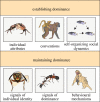The establishment and maintenance of dominance hierarchies
- PMID: 35000449
- PMCID: PMC8743888
- DOI: 10.1098/rstb.2020.0450
The establishment and maintenance of dominance hierarchies
Abstract
Animal groups are often organized hierarchically, with dominant individuals gaining priority access to resources and reproduction over subordinate individuals. Initial dominance hierarchy formation may be influenced by multiple interacting factors, including an animal's individual attributes, conventions and self-organizing social dynamics. After establishment, hierarchies are typically maintained over the long-term because individuals save time, energy and reduce the risk of injury by recognizing and abiding by established dominance relationships. A separate set of behaviours are used to maintain dominance relationships within groups, including behaviours that stabilize ranks (punishment, threats, behavioural asymmetry), as well as signals that provide information about dominance rank (individual identity signals, signals of dominance). In this review, we describe the behaviours used to establish and maintain dominance hierarchies across different taxa and types of societies. We also review opportunities for future research including: testing how self-organizing behavioural dynamics interact with other factors to mediate dominance hierarchy formation, measuring the long-term stability of social hierarchies and the factors that disrupt hierarchy stability, incorporating phenotypic plasticity into our understanding of the behavioural dynamics of hierarchies and considering how cognition coevolves with the behaviours used to establish and maintain hierarchies. This article is part of the theme issue 'The centennial of the pecking order: current state and future prospects for the study of dominance hierarchies'.
Keywords: aggression; contests; dominance relationships; resource holding potential; social instability; social structure.
Figures



References
-
- Drews C. 1993. The concept and definition of dominance in animal behaviour. Behaviour 125, 283-313. (10.1163/156853993X00290) - DOI
-
- Schjelderup-Ebbe T. 1922. Beiträge zur sozialpsychologie des haushuhns. Z. Psychol. Physiol. Sinnesorgane, Abt, 1. Z. Psychol. 88, 225-252.
-
- Wilson EO. 1971. The insect societies. Cambridge, MA: Belknap Press.
-
- Kaufmann JH. 1983. On the definitions and functions of dominance and territoriality. Biol. Rev. 58, 1-20. (10.1111/j.1469-185X.1983.tb00379.x) - DOI
Publication types
MeSH terms
Grants and funding
LinkOut - more resources
Full Text Sources

